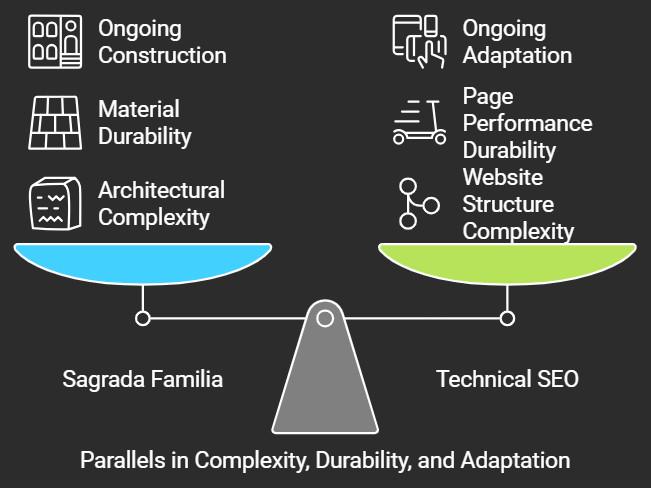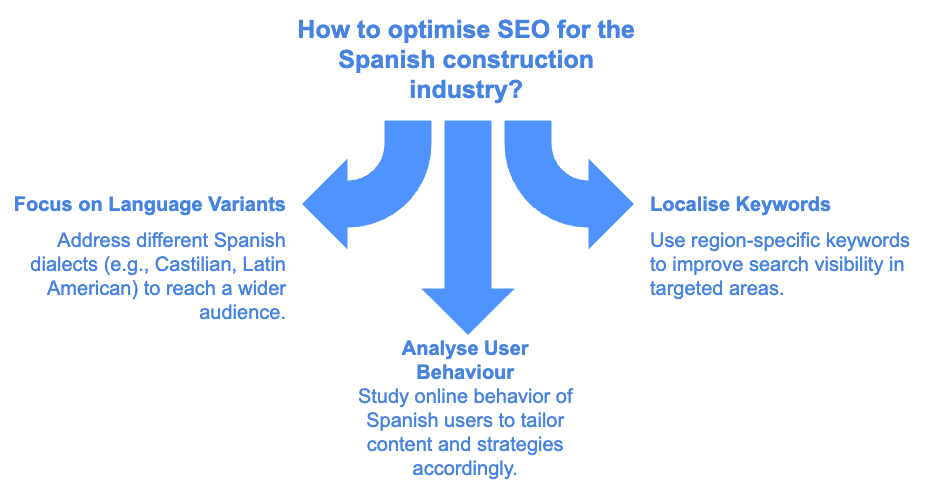Building a Digital Sagrada Familia
Just like Antoni Gaudí’s Sagrada Familia, which has captivated the world with its complexity and precision, building a strong foundation for your digital presence requires meticulous planning and expertise.
In this article, we will explore the intricacies of technical SEO for Spanish markets, drawing parallels to Gaudí’s architectural masterpiece to illustrate the importance of structure, detail, and vision in SEO.
Understanding the Foundations of Technical SEO: The Base Structure
The Foundation: Just like the base of Sagrada Familia holds everything together, site structure and architecture form the base of technical SEO.
It’s crucial to ensure a logical site structure for Spanish users, focusing on ease of navigation.
Cultural Adaptation: Designing for Spanish-speaking audiences also requires attention to cultural nuances in website hierarchy and user experience.
Whether your audience is in Madrid or Valencia, local habits can have an impact on how they engage with your site.

Keyword Research for Spanish Search Engines: Crafting the Blueprints
National and Regional Differences: Keyword research needs to accommodate the differences between Spanish spoken in Spain and Latin American variants. Targeting the right localised keywords helps attract relevant traffic.
Tools and Techniques: Using tools such as Google Keyword Planner, SISTRIX, or SEMrush can reveal high-impact keywords tailored for both national and regional Spanish audiences. Understanding user intent and local terminology is critical.
| Tool | Features | Pricing | Best Use Case | Suitability for Spanish Market |
|---|---|---|---|---|
| Google Keyword Planner | Keyword research, search volume data, trend insights, limited audience targeting | Free for Google Ads users | Basic keyword research and planning, ideal for PPC campaigns | Moderate – limited localisation for Spain-specific keywords |
| SISTRIX | Competitive analysis, visibility index, backlink analysis, SEO benchmarking for regions | Starts at £90/month | Ideal for monitoring search engine rankings and competition | High – strong Spanish market presence |
| Oncrawl | Comprehensive SEO auditing, log analysis, crawl behavior tracking, data visualisations | Starts at £36/month | Technical SEO analysis, useful for large sites needing in-depth auditing | Moderate – English-only interface but supports all market crawls |
| Ahrefs | Backlink analysis, keyword explorer, rank tracking, site audit, content research | Starts at £75/month | Comprehensive SEO tasks, excellent for backlink analysis and competitive research | High – includes Spanish language and keyword support |
| Screaming Frog | Site crawling, identifying broken links, metadata analysis, custom filters | Free (limited), £160/year Pro | Ideal for technical SEO and one-time or regular site audits | High – effective in Spanish markets; requires user-generated keyword input |
Mobile Optimisation: Reflecting the Organic Design of Gaudí
The Mobile Experience: Just like Gaudí’s natural forms, your website must adapt organically for a seamless mobile experience. The increasing use of mobile devices in Spain means mobile responsiveness is vital for effective SEO.
Importance of Mobile SEO in Spain: Spaniards use mobile devices extensively for browsing, which means ensuring mobile-friendly pages and quick load times is crucial to capture this audience.
Mobile vs Desktop Usage Patterns
- According to StatCounter, as of January 2025, mobile devices account for 58.95% of internet usage in Spain, desktops for 39.14%, and tablets for 1.91%. Additionally, Spain’s high smartphone penetration rate (nearly 90% of the population actively using smartphones) highlights the importance of optimising digital strategies for mobile users5.
- For certain content categories like portals (69%), business/finance (58%), and entertainment/news (51%), mobile usage exceeds desktop.
- However, desktop still dominates for categories like online gaming (88%), photos (92%), and maps (94%)

Site Speed and Performance: Building a Strong Infrastructure
Gaudí’s Endurance: The longevity of the Sagrada Familia showcases the importance of robust infrastructure. Likewise, page speed and performance are essential for sustaining strong SEO rankings.
PageSpeed Insights and GTmetrix: Utilising tools like PageSpeed Insights and GTmetrix can help identify performance issues and ensure your website delivers fast, reliable experiences for Spanish users.
| Recommendations | Checklist |
|---|---|
| Image Optimisation |
– Compress images (WebP) – Use responsive sizes – Use tools like TinyPNG, adapt images for screen sizes |
| Server Optimisation | – EU or local hosting – Minimise response time – Choose EU servers, enable GZIP compression |
| Content Delivery |
– Use EU CDN – Enable lazy loading – Use CDN like Cloudflare; lazy load off-screen elements |
| JavaScript & CSS |
– Minify files – Defer non-critical JavaScript – Use tools like UglifyJS; defer non-essential scripts |
| Reduce HTTP Requests |
– Combine files – Limit redirects – Merge CSS/JS, maintain clean URLs |
| Mobile Optimisation | – Responsive design – Optimise for touch – Ensure layout adapts well to mobile |
| Browser Caching |
– Cache static assets – Set cache control headers for faster repeat visits |
| Font Optimisation |
– Use WOFF2 format – Preload primary fonts – Use WOFF2 for smaller file size, preload main fonts |
URL Structure and International SEO: Crafting a Spanish Identity
International Targeting: Geo-targeted URLs such as .es domains are advantageous for SEO in Spain. Proper hreflang tags ensure that search engines serve the right language version to the right audience.
SEO-Friendly URL Structure: To improve localisation, create URL structures that reflect the language and culture of Spanish users, avoiding direct translations that may lose context or relevance.
Schema Markup and Rich Snippets: The Finishing Details
Adding Finesse like Gaudí: Schema markup adds the kind of detail to your website that can make it stand out, just as the intricate carvings of the Sagrada Familia make the basilica unique.
Types of Schema for Spanish Search Engines: Employing event, organisation, and FAQ schema can improve local visibility in Spanish search results, making your content more accessible and appealing.
| Type | Use Case | Impact on Spanish SEO |
|---|---|---|
| Local Business | For Local Businesses with a physical presence. | Optimises for local searches, increasing foot traffic and local engagement. |
| Organisation | Details about a company or organisation. | Enhances brand presence in search results, making it easier for users to find business information. |
| Product | Used for e-commerce products. | Boosts product visibility, allowing for rich results in product searches, especially in local markets. |
| Review | Used for product or service reviews. | Enhances credibility and click-through rates by displaying star ratings in search results. |
| FAQ | Commonly used to answer frequently asked questions. | Improves search visibility and can lead to rich snippets, enhancing click-through rates. |
| Article | For blog posts and news articles. | Improves the chances of appearing as featured snippets, driving more traffic to content. |
| Event | Used for local events, concerts, and festivals. | Increases visibility in local search results and helps users find relevant events nearby. |
| Recipe | Applicable for food and cooking websites. | Increases chances of appearing in recipe searches, attracting food enthusiasts. |
Crawlability and Indexing: The Ongoing Construction
Gaudí’s Unfinished Masterpiece: Like the ever-evolving construction of Sagrada Familia, SEO requires constant adaptation and monitoring.
XML Sitemaps and Robots.txt: Creating and maintaining XML sitemaps and configuring robots.txt files helps ensure effective crawling and indexing by Spanish search engines like Google.es and Bing.
Core Web Vitals: Ensuring Stability in a Complex Structure
User Experience in Spanish Markets: Core Web Vitals are vital to building a great user experience, similar to how Gaudí’s designs focus on the experience of those visiting the basilica.
Improvement Tips: Focus on meeting Google’s thresholds for LCP (Largest Contentful Paint), FID (First Input Delay), and CLS (Cumulative Layout Shift), as these metrics directly influence user satisfaction in Spain.

Technical SEO Tools for Spanish Markets: The Architect’s Toolbox
SEO Tools Specific to Spain: Tools like Google Search Console, SISTRIX, and Oncrawl are essential for site audits and performance monitoring.
Local Insight Tools: To understand the regional landscape, tools that provide local analytics are invaluable for gaining insights into the competitive environment in Spain.
Common Technical SEO Challenges in Spanish Markets: Obstacles in Construction
Challenges with Language and Regional Variants: Navigating the complexity of regional languages like Catalan or Basque can be challenging for site structure and keyword selection.
Spanish-Specific User Behaviour: Understanding user behaviour in Spain, including how users engage differently depending on their region, is key to effectively targeting the market.
Keyword Differences Across Spanish Regions: A map of Spain highlighting differences in keyword usage for Castilian Spanish, Catalan, and Basque regions, providing insight into the importance of localised keywords.

Monitoring, Auditing, and Adaptation: The Ongoing Work of SEO
Much Like Gaudí’s Vision: SEO is an ongoing process, just like the construction of Sagrada Familia. Regular audits and adaptations are necessary to keep your site technically sound and aligned with the evolving landscape.
Tools for Audits: Use tools like Screaming Frog, Ahrefs, and Google Analytics for regular checks on the technical health of your website and to monitor performance within the Spanish market.
Achieving Architectural Mastery in Technical SEO
To build a digital presence as enduring as Gaudí’s Sagrada Familia, you need a solid foundation, careful planning, and ongoing dedication.
From keyword research to Core Web Vitals, every element of technical SEO requires meticulous attention to build a website that stands out in the Spanish market.
Are you ready to build your digital Sagrada Familia?
Contact us today to start optimising your website for Spanish search engines and grow your presence in Spain’s digital landscape. Reach out via email, phone, or our online form for a tailored consultation.
FAQ Section:
What are the main challenges of technical SEO in Spain?
The biggest challenge is linguistic adaptation between Castilian Spanish and regional languages like Catalan and Basque. These differences affect keyword selection and targeting.
Is a local (.es) domain important for ranking well in Spain?
Yes, using a .es domain helps build local credibility and relevance for Spanish users, which can enhance search engine rankings.
How do I optimise my site for regional search engines in Spain?
Use hreflang tags and create content tailored to each specific region to ensure your site is targeted effectively for local users.
Are Core Web Vitals important for SEO in Spain?
Absolutely, Core Web Vitals are crucial, regardless of the market. They significantly impact the user experience and influence ranking on search engines.
Which tools should I use to monitor technical SEO in Spain?
Tools like Google Search Console, SISTRIX, and Screaming Frog are essential for conducting audits and monitoring your website’s performance in the Spanish market.






